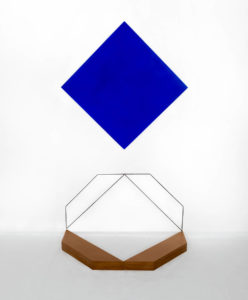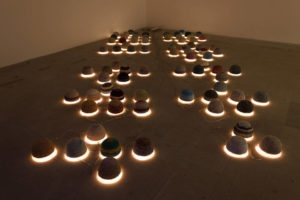 The Jameel Prize is an international prize for contemporary art and design inspired by Islamic tradition. This year’s eight finalists, working in fields as diverse as architecture, fashion, multi-media installation and painting can be seen, for FREE, now at the Victoria & Albert Museum. The Porter Gallery containing the exhibits is to the left of the main desk at the Cromwell Road entrance.
The Jameel Prize is an international prize for contemporary art and design inspired by Islamic tradition. This year’s eight finalists, working in fields as diverse as architecture, fashion, multi-media installation and painting can be seen, for FREE, now at the Victoria & Albert Museum. The Porter Gallery containing the exhibits is to the left of the main desk at the Cromwell Road entrance.
The exhibition is a small one, but it requires the viewer to shift critical perspective a few times; how does one compare a physical building – the Bait ur Rouf Mosque, Dhaka (2012) with a painting – The Translator (oils on linen 2015) with sculptures/installations, Shawl (walnut wood, paint and brass, 2015) and Tâqiya- Nôr, or Hat-Light (multi-media, 2016) and fashion – Wandress collection (2015). Thankfully one didn’t have to judge, merely admire. Though the judges clearly had a hard time too, as, for the first time, the Prize was awarded to joint winners – the architect Marina Tabassum and the artist Mehdi Moutasha.
Tabassum (b.Dhaka, 1969) lives and works in the city of her birth and she was awarded the prize for her mosque, a model of which can be found in the exhibition as well as photographs which show how light is used to truly remarkable effect within it. She builds in traditional materials like brick, but also uses modern stone and tile and is mindful of the purpose and comfort of her building, air flow being particularly important in the humid climate of Bangladesh. To see how she uses changing light as the sun moves across the sky take a look at her video here.
 Moutasha (b.1943, Iraq) lives and works in Arles, France. He is a former Professor at the Ecole Nationale Supérieure des Artes Décoratifs, Paris and he was awarded the prize for his four bold, minimalist works of abstract art rooted in Islamic geometry. It is unsurprising when one thinks about it, of course western abstract art, with its geometrical shapes in the works of Matisse and others, fits well with the Islamic aesthetic tradition of order and line, so clearly seen in Islamic building and gardens. Moutasha seeks to bring the two together.
Moutasha (b.1943, Iraq) lives and works in Arles, France. He is a former Professor at the Ecole Nationale Supérieure des Artes Décoratifs, Paris and he was awarded the prize for his four bold, minimalist works of abstract art rooted in Islamic geometry. It is unsurprising when one thinks about it, of course western abstract art, with its geometrical shapes in the works of Matisse and others, fits well with the Islamic aesthetic tradition of order and line, so clearly seen in Islamic building and gardens. Moutasha seeks to bring the two together.
My other particular favourites include a stunning wooden screen made out of walnut, with brass by the naqsh collective, founded by the Abudail sisters (nermeen, b. 1980 and nisreen, b. 1976)in Amman, Jordan in 2010. The first is a graphic designer and the second an architect and they create art and furniture. They take the 18th and 19th century tradition of embroidery, particularly cross-stitch, in Jordan and Palestine which is so often used on women’s shawls and they collect its designs and motifs digitally then use the motifs in engraving wood, stone, brass and marble. I was absolutely knocked out by the exquisite and delicate patterns, their juxtaposition on different materials and the grace and elegance of the finished article, called Shawl.
out by the exquisite and delicate patterns, their juxtaposition on different materials and the grace and elegance of the finished article, called Shawl.
I also enjoyed the rather sweet and fun Tâqiya-Nôr or Hat-Lights by Younes Rahmoun (b.1975, Tetuan, Morocco). This consists of a collection of embroidered skullcaps, worn by Muslim men on the streets and in the mosque, which are placed in abstract patterns but always facing in the direction of Mecca. Each is then underlit with a LED light. The photograph of this work doesn’t do it justice as the intricacy of the patterns on the hats isn’t captured. Presumably, if one is standing at the front of the Prayer Hall, the skull caps are what  one sees as the men bend to pray.
one sees as the men bend to pray.
I confess, I didn’t know the Jameel Prize existed before going to see this exhibition earlier in the week. The quality of the finalists was astonishing, and across such a wide range of disciplines. There has never been a better time to bring the aesthetic and art of Islam to the West, as the artistic traditions come together. I will look out for it in future.
The exhibition of Jameel Prize Finalists is at the V & A Museum, London until 25th November. It is FREE to enter. I recommend that it is well worth a visit.
For more on art and exhibitions why not try Picasso 1932 Lin Mae Saeed – Bees


 RSS – Posts
RSS – Posts